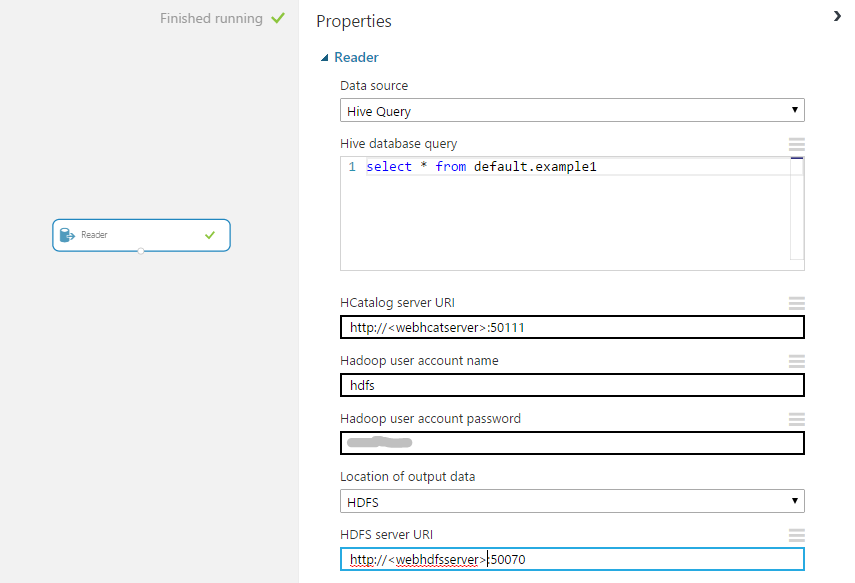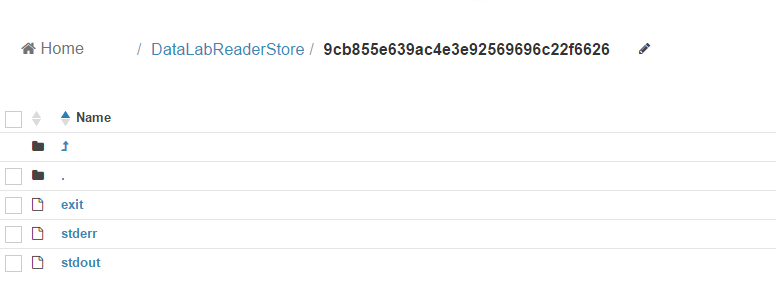Connect Cloudera to Azure ML Hive Reader
Azure Machine Learning supports Hive as a data source using WebHCat API. In this post, I will show you how to configure Cloudera to connect to Azure ML through WebHCat. These steps have been verified on a Cloudera cluster created from Azure Marketplace. If you don't already have a cluster, you can follow this blog post to deploy one. We will use Cloudera Manager to configure the cluster.
Step 1: Enable WebHCat
By default, Cloudera cluster created from Azure Marketplace doesn't have WebHCat enabled. To enable it, go to Cloudera Manager, select Hive, and Add Role Instances:
You can see WebHCat server doesn't have a host, so click Select Hosts:
Follow the wizard to select a host, and start the WebHCat server.
Step 2: Expose WebHCat Endpoint
In order to run Hive queries, we need to configure the Azure VM endpoint to expose WebHCat. To do this, login to the Azure Portal, select the VM that's running WebHCat server, then go to the ENDPOINTS tab to add an endpoint. By default, WebHCat runs on 50111. You can choose a public port that's different from the private port. But for simplicity, we will keep them same here:
Now we can run DDL commands using WebHCat. For example, to list Hive databases, run:
https://<webhcatserver>.cloudapp.net:50111/templeton/v1/ddl/database?user.name=hdfs
To list tables in the default database, run:
https://<webhcatserver>.cloudapp.net:50111/templeton/v1/ddl/database/default/table?user.name=hdfs
However, we are not able to run Hive queries yet. This is because the default WebHCat configuration includes jars that are not in the Cloudera cluster environment, and Hive meta store URIs need to be updated.
Step 3: Configure WebHCat
To update WebHCat configuration, go to Cloudera Manager, select Hive, Configuration, and type "webhcat" in the Search box to narrow down the configuration. Update "WebHCat Server Advanced Configuration Snippet (Safety Valve) for webhcat-site.xml" section as following:
The configuration should include the following. Note that the settings here correspond to the Cloudera environment deployed by Azure Marketplace, if you are using a different cluster, you might need to adjust the settings to match your cluster.
<property>
<name>templeton.libjars</name>
<value>/opt/cloudera/parcels/CDH/lib/zookeeper/zookeeper.jar</value>
<description>Jars to add to the classpath.</description>
</property>
<property>
<name>templeton.hive.path</name>
<value>/opt/cloudera/parcels/CDH/lib/hive/bin/hive</value>
<description>The path to the Hive executable.</description>
</property>
<property>
<name>templeton.hive.properties</name>
<value>hive.metastore.uris=thrift://<hivemetastoreserver>:9083</value>
<description>Properties to set when running hive.</description>
</property>
After the configuration is updated, restart WebHCat server for the update to take effect. Now, we should be able to run Hive queries via WebHCat. For example, to select all rows from table "example1" in the default database, run:
curl -s -d user.name=hdfs -d execute="select+*+from+default.example1;" 'https://<webhcatserver>.cloudapp.net:50111/templeton/v1/hive'
WebHCat writes its job output to /templeton-hadoop, so Hive user must have access to this hdfs folder. You can go to Hadoop UI or Hue to view the job status.
Step 4: Connect to Azure ML
Log in to Azure ML Studio, click on your Reader module, and select "Hive Query". Configure Hive as following with your own WebHCat server URL, HDFS user, and HDFS Server URL:
Run the experiment, and verify that the result of the job is written to /DataLabReaderStore in HDFS:





